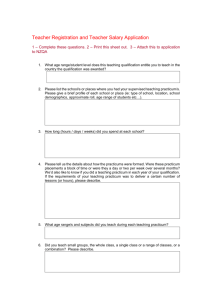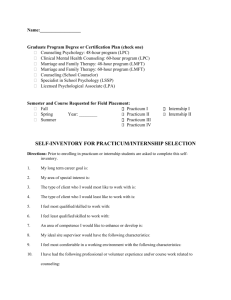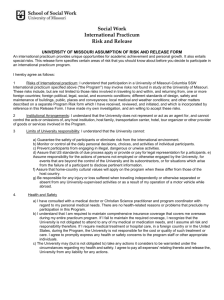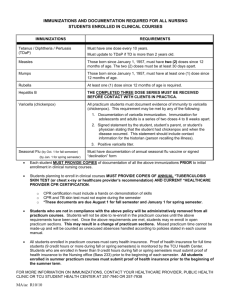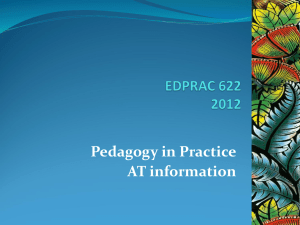Concentration Year
advertisement
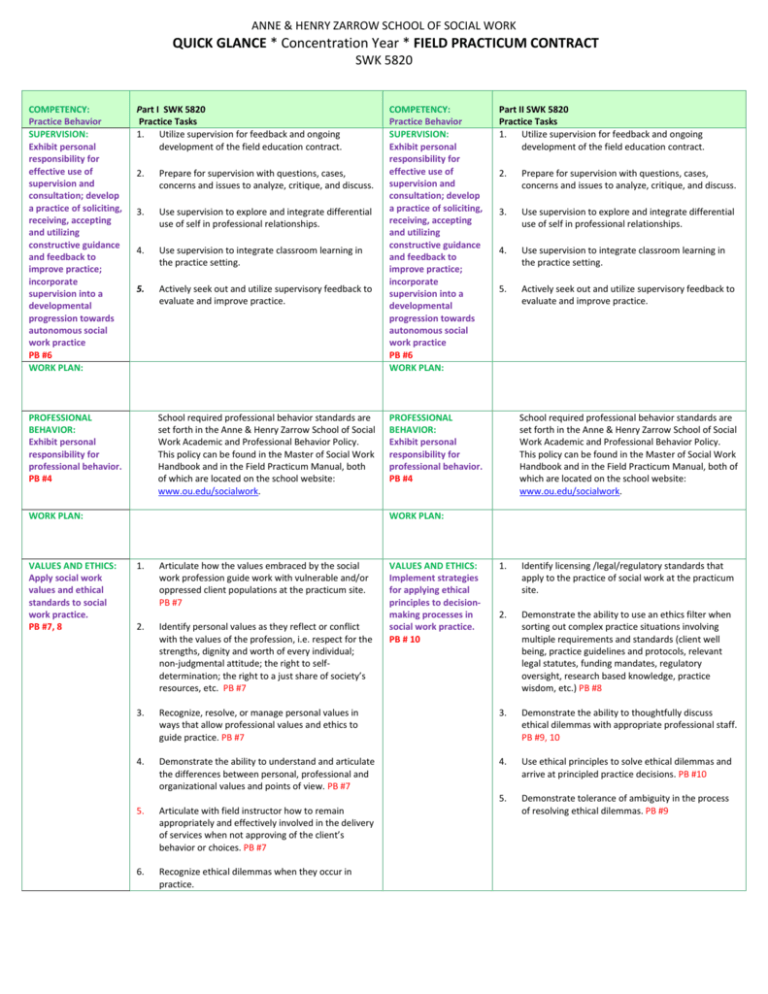
ANNE & HENRY ZARROW SCHOOL OF SOCIAL WORK QUICK GLANCE * Concentration Year * FIELD PRACTICUM CONTRACT SWK 5820 COMPETENCY: Practice Behavior SUPERVISION: Exhibit personal responsibility for effective use of supervision and consultation; develop a practice of soliciting, receiving, accepting and utilizing constructive guidance and feedback to improve practice; incorporate supervision into a developmental progression towards autonomous social work practice PB #6 WORK PLAN: Part I SWK 5820 Practice Tasks 1. Utilize supervision for feedback and ongoing development of the field education contract. 2. Prepare for supervision with questions, cases, concerns and issues to analyze, critique, and discuss. 3. Use supervision to explore and integrate differential use of self in professional relationships. 4. Use supervision to integrate classroom learning in the practice setting. 5. Actively seek out and utilize supervisory feedback to evaluate and improve practice. PROFESSIONAL BEHAVIOR: Exhibit personal responsibility for professional behavior. PB #4 School required professional behavior standards are set forth in the Anne & Henry Zarrow School of Social Work Academic and Professional Behavior Policy. This policy can be found in the Master of Social Work Handbook and in the Field Practicum Manual, both of which are located on the school website: www.ou.edu/socialwork. WORK PLAN: VALUES AND ETHICS: Apply social work values and ethical standards to social work practice. PB #7, 8 COMPETENCY: Practice Behavior SUPERVISION: Exhibit personal responsibility for effective use of supervision and consultation; develop a practice of soliciting, receiving, accepting and utilizing constructive guidance and feedback to improve practice; incorporate supervision into a developmental progression towards autonomous social work practice PB #6 WORK PLAN: Part II SWK 5820 Practice Tasks 1. Utilize supervision for feedback and ongoing development of the field education contract. 2. Prepare for supervision with questions, cases, concerns and issues to analyze, critique, and discuss. 3. Use supervision to explore and integrate differential use of self in professional relationships. 4. Use supervision to integrate classroom learning in the practice setting. 5. Actively seek out and utilize supervisory feedback to evaluate and improve practice. PROFESSIONAL BEHAVIOR: Exhibit personal responsibility for professional behavior. PB #4 School required professional behavior standards are set forth in the Anne & Henry Zarrow School of Social Work Academic and Professional Behavior Policy. This policy can be found in the Master of Social Work Handbook and in the Field Practicum Manual, both of which are located on the school website: www.ou.edu/socialwork. WORK PLAN: 1. Articulate how the values embraced by the social work profession guide work with vulnerable and/or oppressed client populations at the practicum site. PB #7 2. Identify personal values as they reflect or conflict with the values of the profession, i.e. respect for the strengths, dignity and worth of every individual; non-judgmental attitude; the right to selfdetermination; the right to a just share of society’s resources, etc. PB #7 3. VALUES AND ETHICS: Implement strategies for applying ethical principles to decisionmaking processes in social work practice. PB # 10 1. Identify licensing /legal/regulatory standards that apply to the practice of social work at the practicum site. 2. Demonstrate the ability to use an ethics filter when sorting out complex practice situations involving multiple requirements and standards (client well being, practice guidelines and protocols, relevant legal statutes, funding mandates, regulatory oversight, research based knowledge, practice wisdom, etc.) PB #8 Recognize, resolve, or manage personal values in ways that allow professional values and ethics to guide practice. PB #7 3. Demonstrate the ability to thoughtfully discuss ethical dilemmas with appropriate professional staff. PB #9, 10 4. Demonstrate the ability to understand and articulate the differences between personal, professional and organizational values and points of view. PB #7 4. Use ethical principles to solve ethical dilemmas and arrive at principled practice decisions. PB #10 5. 5. Articulate with field instructor how to remain appropriately and effectively involved in the delivery of services when not approving of the client’s behavior or choices. PB #7 Demonstrate tolerance of ambiguity in the process of resolving ethical dilemmas. PB #9 6. Recognize ethical dilemmas when they occur in practice. WORK PLAN: WORK PLAN: PROFESSIONAL IDENTITY: Identify as a professional social worker in the practice setting and ensure client access to all social work services. PB# 1, 3 1. Distinguish the social work perspective from the perspectives of other professional approaches. 2. Describe the social worker’s scope of professional responsibility and authority at the practicum site. PB # 3 3. Discuss with field instructor any personal challenges or concerns with assuming this level of responsibility and authority. PB # 3 4. 1. Identify as a social worker in interdisciplinary relationships and in the community. PB # 3 2. Serve as a representative of the social work profession during professional activities and events both within and outside the practicum site. 3. Demonstrate professional roles and contextappropriate professional boundaries with clients, colleagues, and other service providers. PB # 3 Demonstrate professional roles and contextappropriate professional boundaries with clients, colleagues, and other service providers. 4. Practice personal reflection and self-correction to assure continual professional development. CSWE #2 PB # 2 5. Demonstrate familiarity with clients’/target population’s needs and concerns related to receiving services. PB # 1 5. Identify and understand one’s own professional strengths, challenges, and limitations. PB # 2 6. 6. Advocate for client access to applicable support and social work services. PB # 1 Identify a learning process that can be incorporated into a career-long plan to address these strengths, challenges, and limitations. PB # 5 1. Identify changes needed to improve the quality of site related social services, both in the community and at the practicum site. PB # 28 2. Collaborate with colleagues and clients in an effort to improve the delivery of services. PB # 28 3. Develop strategies to implement the changes. PB # 28 WORK PLAN: PROFESSIONAL IDENTITY: Identify as a professional social worker in interdisciplinary relationships within the practice setting and in the human services community. PB# 3 WORK PLAN: PROFESSIONAL CONTEXT: Recognize and respond to the evolving organizational, community, and societal contexts of social work practice. PB # 27 1. Demonstrate an awareness of how changing locales, populations, scientific and technological developments, organizational structures, the economy and emerging societal trends impact services and social work practice at the practicum site. PB # 27 2. Identify how the site has gone about being informed, resourceful, and productive in responding to these changes. PB # 27 3. Identify programs/services, relevant to these changes, which have been or are being developed by the agency. PB # 27 4. Identify how the site is being reactive to these changes, i.e. responding in ways that are not productive to the provision of quality social services. PB # 27 5. Identify societal trends that affect personal biases towards related services. PB # 27 WORK PLAN: PROFESSIONAL CONTEXT: Demonstrate leadership in promoting sustainable changes in service delivery and practice in order to improve the quality of social services. PB # 28 WORK PLAN: HUMAN RIGHTS AND SOCIAL JUSTICE: Apply knowledge of oppression and engage in practices that advance social, economic, and political justice in working with diverse populations and 1. 2. Demonstrate awareness and understanding of the forms, mechanisms and effects of oppression, discrimination and historical trauma to guide treatment planning and interventions with clients at the practicum site. PB # 18, 20 Identify strategies of change utilized by the practicum site that advance social and economic justice. PB # 20 2|Page HUMAN RIGHTS AND SOCIAL JUSTICE: Advocate for human rights and social, economic, and political justice. PB # 19 1. Assess agency practice for barriers to equal opportunity, access and treatment. PB # 20, 1 2. Evaluate the efficacy of existing site programs and services in promoting justice and preventing/alleviating the economic and social inequalities which are relevant to the practicum site. PB # 20 3. Identify practicum site involvement with organizations. PB # 20, 18 3. Develop and apply knowledge of culturally appropriate, effective, empowering change strategies that promote social justice and client autonomy. PB # 20 constituents to create/support change efforts that effectively increase the social, cultural, political and economic empowerment of vulnerable and marginalized populations. Participate to whatever extent possible in these efforts. PB # 19 4. Develop and apply advocacy skills to advance justice for diverse populations in the community, or served by the practicum site. PB # 19 1. Evaluate the efficacy of existing social and site policies in promoting justice and preventing/alleviating economic and social inequalities relevant to the practicum site. PB # 14, 26, 18, 19 2. Identify ways the practicum site is engaged in influencing policy formulation and change. PB # 26 Articulate the implications of policies and policy change in the lives of clients. PB # 25 3. Identify changes needed to make policy more responsive to practicum site client needs. PB # 26 Demonstrate the ability to articulate the parameters of a specific agency policy to clients. PB # 25, 13 4. Identify the role of direct social work practice in policy development. PB # 20, 26 Analyze how that specific agency policy is derived from a broader social policy. PB # 25 5. Develop strategies involving colleagues, clients and organizations to improve service delivery through policy change/development. Identify the role of direct social work practice in policy development. PB # 26, 1 1. Apply insight regarding the life experiences of diverse clients to the development of interventions that are culturally sensitive and appropriate. PB # 16, 17 2. Practice with methodological approaches, skills, and techniques that reflect an understanding of the role of culture in the helping process. PB # 16, 17 3. Demonstrate the role of ‘cultural learner’ and appreciation of the client as ‘informant.’ PB # 17 4. If possible at the practicum site, advocate for and/or participate in education and training programs that advance cultural competence within or outside the site. PB # 16 WORK PLAN: WORK PLAN: SOCIAL POLICY: Analyze the implications of policy on client problems. PB # 25 1. Demonstrate the ability to analyze sociopolitical factors that impact the lives and problems of practicum site clients. PB # 25, 14 2. Identify the structural/societal sources and uses of power and authority that shape policy and services formation at the practicum site. PB # 27, 25 3. 4. 5. WORK PLAN: SOCIAL POLICY: Demonstrate leadership in critiquing policy and advocating for policy change. PB # 26 WORK PLAN: DIVERSITY: Apply knowledge of the profound impact of ‘difference’ on the life experience of the client; communicate understanding of this knowledge to the client throughout the practice process. PB # 16, 14 1. Articulate with field instructor insight regarding the life experiences of the ‘different’ client. PB # 16 2. Recognize personal biases and values while working with diverse populations. PB # 15 3. Gain sufficient self-awareness to eliminate the influence of personal biases and values in working with diverse individuals and groups. PB # 15 4. Demonstrate the ability to listen to clients until they feel understood. 5. Generate verbal and nonverbal practice skills that appropriately communicate insight and understanding of the impact of ‘difference’ in life experiences. PB # 16 6. Communicate information about diverse client groups to other professionals. PB # 16 WORK PLAN: DIVERSITY: Apply a culturally sensitive approach when working with diverse clients and communities. PB # 15, 16, 17 WORK PLAN: 3|Page HBSE/THEORY: Utilize multiple theoretical frameworks to understand ‘person in environment’ in the application of social work practice with clients. PB # 23 1. Articulate multiple theoretical frameworks used in social work practice that are relevant to the practicum site. PB # 23 2. Select and apply appropriate theoretical frameworks to guide assessments and interventions with clients. PB # 23 1. Critically analyze the extent to which practicum site frameworks are compatible with a person-inenvironment understanding of human development and behavior. PB # 23, 24, 12 WORK PLAN: HBSE/THEORY: Demonstrate the ability to critique the effectiveness of theoretical approaches in social work practice with clients. PB # 24 1. Evaluate the strengths, weaknesses, and potential effectiveness of different theoretical approaches for each client. PB # 24, 12 2. Determine which theories provide best practice for specific clients and clinical/practice situations. PB # 24, 12 1. Articulate one’s own personal strengths and limitations in utilizing various clinical/practice theories. PB # 24 1. Identify a current or potential practicum site based research question that could advance practice knowledge. PB # 21 2. Identify the agency’s need for knowledge building. PB # 21 3. Evaluate the effectiveness of one’s own practice skills, using protocols and procedures that are sensitive to agency concerns; make revisions in skills as necessary. (PB # 21) 1. Distinguish, appraise, and integrate multiple sources of knowledge, including empirically supported knowledge and practice wisdom, for effective decision-making. PB # 11 WORK PLAN: RESEARCH: Use research findings to inform social work assessments and interventions. PB # 22 1. Identify empirically-based knowledge/research findings relevant to social work practice at the practicum site. PB # 22 2. Utilize research findings to identify appropriate assessment procedures, select effective client interventions/strategies and monitor practice effectiveness. PB # 22, 12 3. RESEARCH: Use practice experience to inform scientific inquiry. PB # 21 Identify the site’s existing utilization of empirical methods of practice evaluation. (PB # 21) WORK PLAN: WORK PLAN: CRITICAL THINKING: Apply critical thinking skills, logic, scientific inquiry, and reasoned discernment to professional judgment in social work practice. PB # 11, 12 1. Analyze and evaluate agency models of assessment, prevention, intervention and evaluation in terms of their appropriateness for the agency’s clients and target systems. PB # 12 2. Analyze the degree to which the agency assessment process adequately yields information that guides intervention planning. PB #12 2. Use well-reasoned practice conclusions and solutions, testing them against relevant criteria and standards. PB # 11 3. Identify multiple possible responses to client problems and evaluate the consequences of the identified responses. PB # 12 3. Apply critical thinking to communicate professional judgment to other professionals in both oral and written format. PB # 13 4. Cultivate and use a “critical third eye,” the ability to be an observer and evaluator of one’s own thinking, actions and consequences. PB # 11 WORK PLAN: CRITICAL THINKING: Use creative synthesis of knowledge for effective practice decision making. PB # 11 WORK PLAN: PRACTICE: Apply the knowledge and skills of an integrated and contextualized social work perspective to practice with individuals, families and groups; progress This section of the Contract is devoted to the direct social work practice process. Practicum students must demonstrate competence in the beginning, middle and ending phases of this process over the span of the practicum. In the Field Practicum Contract, practice competence is broken into five (5) practice steps the student must demonstrate during the practicum. Individual students progress at different rates and practicum sites vary widely in the types and organization of social services they offer. Therefore, some placements may include all five practice steps early in the practicum and others may introduce the student to them gradually. However, over the course of the practicum experience, Concentration Year students must demonstrate competence in all practice steps. In addition to practice steps, assignments in this section must also include written professional communication which is directly linked to the student’s practice activities with clients/client systems. If needed, professional writing assignments can be created only for use in the practicum 4|Page towards independent work with clients, based upon selfmonitoring and select utilization of informed supervisory guidance and consultation. PB #6 and destroyed later. DEMONSTRATION OF PRACTICE COMPETIENCE MUST BE DIRECTLY OBSERVED AND EVALUATED BY THE FIELD INSTRUCTOR OR BY A PRECEPTOR FOR EACH PRACTICE STEP. There are two grading checkpoints, one at mid-practicum and one at the end of the practicum. Instructor observations should occur when the student has achieved his/her highest level of performance in each practice step. At evaluation, along with a performance rating, each instructor will signify the process by which the student was exposed to and given opportunity to participate in each step of the practice process. This will be signified by entering all relevant numbers from the scale below. A student could have as many as six numbers for one practice step, depending on the learning process involved. Learning Process 1 = Read about or receive oral information 2 = Shadowed during client system interactions 3 = Shared responsibility for parts of an interaction/project 4 = Took full responsibility for parts of interaction/project 5 = Took full leadership in organizing interaction/project 6 = Took full leadership in implementing interaction/project PRACTICE Preparation Preparation 1. Identify and become familiar with specialized knowledge and skills needed to practice in the practicum placement’s area of social work practice. Some examples: PB# 5, 29 Some examples: Child Welfare (knowledge of the legal system) Schools (safely plans, IDEA) Mental Health (DSM, psychotropic medication) Veterans (privacy training, PTSD/TBI framework) Medical (medical terminology) Drug & Alcohol Prevention (assessment tools) Special Training (crisis intervention, suicide assessment, etc.) 2. Actively prepare for work with clients by collecting, organizing and interpreting client information. PB # 29 3. Affectively prepare for action with clients. PB # 29 4. Seek supervisory guidance as necessary. PB # 6 WORK PLAN: PRACTICE Engagement Engagement 1. Demonstrate ability to develop and maintain strengths based relationships and processes with a variety of client systems. PB # 30 2. Identify special engagement needs of diverse clients. PB # 29 3. Demonstrate ability to explain to clients the “big picture,” i.e. the context of your engagement with them, the nature of your role, how the process of continued engagement will work and what is known about what to expect. PB # 3 4. View self as a “learner” and clients as “informants.” PB #17 5. Apply basic interviewing skills (active listening, appropriate use of empathy & compassion, differential use of self, language that is affirmative, constructive and encouraging, etc.) to respectfully engage diverse client systems; recognize and demonstrate other interpersonal skills as needed when working with clients. PB # 30, 13 6. Generate verbal and nonverbal skills that communicate insight and understanding of the impact of ‘difference’ in life experiences. PB # 16 7. Develop a mutually agreed upon focus of work and desired outcomes. PB # 31 8. Accurately convey the operative extent of client confidentiality. PB # 3 WORK PLAN: 5|Page PRACTICE Assessment Assessment 1. Demonstrate familiarity with requirements of the specific assessment process. PB # 32 2. Utilizing a person-in-environment perspective , work collaboratively with clients to assess specific problems, strengths, limitations, challenges, coping patterns, motivation, assets and opportunities. PB # 33 Demonstrate effective use of engaging skills when performing assessments. PB # 30 3. 4. Demonstrate ability to use both close-ended and open-ended questions and an understanding of when each is more effective. PB # 30 5. Recognize and distinguish between verbal and nonverbal communication as expressed by clients during the assessment process. PB # 30 6. Demonstrate ability to translate data collection into the assessment form or format. PB # 32 7. Develop mutually agreed upon goals and objectives. PB # 34 8. Identify and select appropriate intervention strategies. PB # 35 9. Demonstrate effective oral and written communication of the assessment process and outcome. PB # 13 Although students may use assessment instruments to help guide them, in the practicum they must assess by engaging clients in an interview format. If opportunities to conduct this type of assessment are not available at the practicum site, field instructors will need to create opportunities for the student. In that event, the student may do a social history, needs assessment, Genogram, focus group, ecomap, etc. At evaluation, as with all of the practice steps, the student’s rating must be based on actual observation of assessment interviewing performance and professional communication about the assessment process and outcome. 10. Define the assessment outcome with implications for both micro and macro change. PB # 35, 33 WORK PLAN: PRACTICE Intervention Intervention 1. Initiate actions to achieve organizational goals. PB #36 2. Help clients resolve problems. PB #38 3. Demonstrate ability to execute micro/mezzo tasks working directly with clients. (PB #37) 4. Demonstrate ability to execute macro tasks on behalf of clients. (PB #37) 5. Implement prevention intervention strategies that enhance client capacities. PB #37 6. Apply knowledge of resources appropriate to clients. PB #1, 37, 40 7. Facilitate appropriate referrals, transitions and endings with the practicum facility. PB #40 6|Page 8. Negotiate, mediate, and advocate for clients. PB #39 WORK PLAN: PRACTICE Evaluation Evaluation 1. Critically monitor, analyze and evaluate intervention outcomes and effectiveness. PB #41 2. Utilize evaluation feedback to confirm, update or alter intervention strategies. PB #41 3. Evaluate the degree to which selected interventions do or do not build client autonomy. PB #41 4. Incorporate evaluation information into ongoing practice behavior. PB #5,2 5. Practice personal reflection, self monitoring and self-correction to assure continual professional development. PB #2 1. Demonstrate appropriate, focused, and wellorganized oral communication skills with clients and at agency and community meetings. PB # 13, 4, 3 WORK PLAN: PROFESSIONAL COMMUNICATION: Apply critical thinking skills, social work ethics, professional discernment and judgment in communicating with, about, or in behalf of client systems - in both oral and written format. PB# 4, 13, 32, 3 2. 3. Demonstrate ability to organize and record accurate client data, assessments, intervention efforts and outcomes, in appropriate formats utilizing professional terminology. PB #3, 13, 32 Demonstrate appropriate, focused and well organized written communication skills in reports and professional correspondence. PB #3, 4, 13 WORK PLAN: PROFESSIONAL COMMUNICATION: Apply critical thinking skills, social work ethics, professional discernment and judgment in communicating with, about, or in behalf of client systems - in both oral and written format. PB# 4, 13, 32, 3 WORK PLAN: 7|Page 1. Demonstrate appropriate, focused, and wellorganized oral communication skills with clients at agency and community meetings. 2. Demonstrate ability to organize and record accurate client data, assessments, intervention efforts and outcomes, in appropriate formats utilizing professional terminology. 3. Demonstrate appropriate, focused and well organized written communication skills in reports and professional correspondence.
